Charting a New Flavor Course
INGREDIENTS
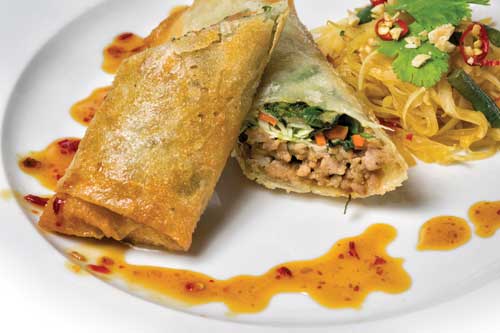 Global cuisines are more popular than ever, thanks in part to the proliferation of cooking shows and cookbooks, movement of people across borders, and consumers’ general willingness to try new foods. Two-thirds of consumers eat a wider variety of ethnic cuisines now versus five years ago, according to the National Restaurant Association (NRA 2015). In particular, foods and ingredients from Asia—everything from sushi, matcha tea, and kimchi to gochujang, fish sauce, and ghee—seem to be garnering the most attention, especially as they become more available at grocery stores and online retailers and in restaurants. Asia is a vast region with a diverse population whose differences in culture, politics, religion, and location have shaped their cuisines and consumption patterns. Exploration, colonization, and immigration have also influenced the cuisines, and these influences can be seen in the ingredients and preparation methods used.
Global cuisines are more popular than ever, thanks in part to the proliferation of cooking shows and cookbooks, movement of people across borders, and consumers’ general willingness to try new foods. Two-thirds of consumers eat a wider variety of ethnic cuisines now versus five years ago, according to the National Restaurant Association (NRA 2015). In particular, foods and ingredients from Asia—everything from sushi, matcha tea, and kimchi to gochujang, fish sauce, and ghee—seem to be garnering the most attention, especially as they become more available at grocery stores and online retailers and in restaurants. Asia is a vast region with a diverse population whose differences in culture, politics, religion, and location have shaped their cuisines and consumption patterns. Exploration, colonization, and immigration have also influenced the cuisines, and these influences can be seen in the ingredients and preparation methods used.
Consumer interest in Asian cuisine has moved beyond a generalization of a particular cuisine or Americanized versions of foods to foods that are authentic and truer to the various regions of a country. Where chop suey, crab Rangoon, and fortune cookies were once thought of as exotic Chinese cuisine, consumers are now more educated about Chinese and other Asian cuisines. In fact, there is a lot of curiosity about the cuisines of other regions of Asia, says Christine Keller, director of trend practice at CCD Innovation, Emeryville, Calif. (ccdinnovation.com). One cuisine in particular that is gaining traction is Filipino, which has been influenced by the Chinese, Malaysian, Indonesian, and Spanish and has flavors that are not too spicy but are rather “a little more fermented and funky,” she says. While Filipino food uses some ingredients that are unfamiliar to many Americans, and is often thought of as being heavy on pork, sugar, and salt, some chefs are serving traditional Filipino fare or updated versions of classic dishes in restaurants, according to CCD Innovation’s Culinary Trend Mapping Report: Filipino Fresh (CCD 2015). Offerings like banana ketchup, adobo, lumpia, and halo-halo have potential in QSR and casual dining restaurants and in categories like prepared meals, frozen meals, sauces, condiments, and snacks, the report found.
As far as some trending ingredients and foods are concerned, Chris Warsow, corporate executive chef at Bell Flavors & Fragrances, Northbrook, Ill. (bellff.com), says gochujang, Korean BBQ, and ramen are three to watch. He points out that gochujang, the fermented chili paste used in Korean cuisine, “hits all of the right flavor notes of spicy and savory.” Korean BBQ is the Korean method of grilling meat, usually using a small grill on the tabletop, and serving it with garlic, vegetables, and flavorful sauces. Warsow says that meat snacks are available in Korean BBQ flavor, and that the flavor is being used in traditional salty snacks as well. One that he proposes: Korean BBQ popcorn. As for ramen, he believes that it is finally getting the attention that it deserves, moving from being a cheap eats option for college students to being the main entrée at hip ramen shops. “The many broths that are offered can keep you interested in this trend,” explains Warsow. This is a very approachable food for Americans looking for the most authentic experience possible, he adds.
Keep an eye out in this article for descriptions of some Filipino product concepts, gochujang, Korean BBQ, and more developed by food technologists and chefs. Of course, what follows is designed to provide inspiration for your product development efforts as you learn a little more about the many Asian ingredients that are available and how these ingredients function in both product and menu concepts.
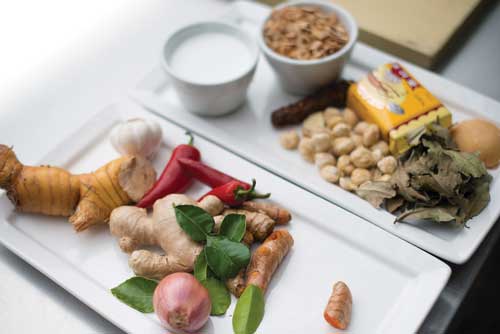 Flavorings Bring Asian Flair to Foods
Flavorings Bring Asian Flair to Foods
For a comprehensive range of flavorings inspired by Southeast Asian cuisines, product developers can turn to Bell Flavors & Fragrances. The company’s new collection introduced this summer includes familiar flavors like lime, basil, and cilantro. It also branches out to flavors that the average American might not know much about, such as pandan, a plant whose leaves have sweet, floral, and vanilla-like flavor notes; sambal goreng, one of many different types of sambal sauces made from chili pepper, shallots, and garlic; and hoisin, a thick sauce-like ingredient made from fermented soybeans, garlic, spices, and sometimes sugar and vinegar.
Asian citrus flavors are quite popular right now, and one that Warsow points to in particular is calamansi lime, which is a hybrid of a mandarin orange and a kumquat. Calamansi lime is popular in Filipino cuisine, giving meat and fish a sharp citrus note, he says. Bell’s calamansi lime flavor has a bright acidic citrus profile and can be used in applications like dressings and sauces. Another popular flavor is fish sauce. Fish sauce is made from fermented anchovies and salt, but some food manufacturers do not want to introduce fish allergens into their processing facilities, says Warsow. Bell’s solution to this is an allergen-free fish sauce flavor that allows food manufacturers to add the fermented and umami notes to soups, sauces, and other applications without the fish allergens.
Product concepts served at recent food shows illustrate the versatility of Bell’s Asian flavorings, which are formulated to capture many of these flavor and aroma notes, in both traditional Asian and non-Asian foods and beverages. At the 2015 SupplySide West show, the company developed a citrusy and spicy Kumquat Ginger Gummy made with its kumquat and ginger flavors and Thai Basil Mint Lemonade that had hints of licorice from its Thai holy basil flavor. The Bo Kho Bao product concept featured at the IFT15 expo was Bell’s twist on a traditional Vietnamese stew. Bo kho is a beef stew made with various aromatic ingredients. Bell’s version featured its beef, bo kho spice, lime juice, umami enhancer, basil, and fish sauce flavor ingredients, and was served on bao, yeast-raised bread that is steamed rather than baked. Hotteok is a thick, pancake-like snack with a sweet filling. The hotteok product concept developed by Bell was formulated with red bean paste, which is made from cooked adzuki beans mashed with a sweetener and enhanced with the company’s red bean paste flavor, which has an earthy sweet flavor profile. Other flavors that would pair well with red bean paste or other sweet fillings are yuzu, calamansi lime, coconut, taro, and halo-halo.
The company’s line of Asian-inspired flavors enhance not only Asian foods like hotteok and bo kho, but also traditional baked goods and beverages like cupcakes and tea. Give plain cupcakes a tropical twist with flavors like lychee. For a Sweet Potato Cupcake, Bell boosted the flavor of the sweet potato batter with its sweet potato flavor. Other Bell flavor offerings to consider for baked goods are rambutan, coconut, calamansi lime, halo-halo, yuzu, and pandan. Try flavors like white peach and chai to formulate ready-to-drink tea beverages. Bell showcased these flavors in White Peach Tea and Chai Cardamom Tea beverages. Don’t stop with these flavors for your beverages; Bell suggests flavor combinations like grapefruit thyme, Vietnamese iced tea, blueberry hibiscus, Ethiopian spice, jasmine plum, and mango coconut.
--- PAGE BREAK ---
Soy Sauce Shines in Unexpected Applications
Kikkoman traces its history back to the mid-17th century when in the city of Noda two families led the way in soy sauce production. Over the years, more soy sauce producers emerged, and in the early 20th century, three merged to form what eventually became the Kikkoman Corp. Today, the company offers a comprehensive line of soy sauces, including low-sodium and gluten-free versions, naturally derived flavor enhancers, teriyaki sauces, and various Asian sauces and seasonings to food manufacturers and foodservice operators.
Kikkoman Sales USA, San Francisco, Calif. (kikkomanusa.com/foodmanufacturers), recently introduced Less Sodium Gluten-Free Tamari Soy Sauce that promises to deliver savory and umami tastes with 40% less sodium than traditional tamari soy sauce. At the IFT15 expo, the company demonstrated the functionality of the ingredient in a Southwest Chile-Lime Beef product concept. Tamari soy sauce is typically made with little or no wheat and is darker in color, milder in flavor, and more aromatic than traditional soy sauce. While it can be used in the same foods as soy sauce, the sensory qualities of tamari soy sauce make it a great addition to dipping sauces and dressings, where it’s richer, more balanced flavor shines.
Something else that you may have noticed about the product concept is that it represents Southwestern U.S./Latin cuisine, not Japanese cuisine. This is something that Kikkoman emphasizes—its ingredients are great in traditional Asian foods, but they also enhance the flavor of many non-Asian foods, says Elizabeth Gibson, coordinator, food service and industrial marketing at Kikkoman Sales USA. Soy sauce is rich in umami compounds, and Kikkoman’s traditional brewing process—a process that requires several months and that involves adding Aspergillus to soybeans and wheat to make Koji mold, which plays an important role in fermentation and developing the taste of soy sauce, fermenting the mash, and refining—also produces a complex balance of sweet and salty tastes. Kikkoman produces several versions of both liquid and granulated soy sauces. The ingredient contributes color and enhances flavor in beef and chicken entrees, balances sweet and smoky flavor and contributes salt for curing in bacon and cured meat, and enhances flavor in soups, broths, stews, and sauces. This is not all though, as the company’s food scientists have shown that soy sauce also adds a bit of complexity to the flavor of and tempers sweetness in cookies and cakes, enhances the dairy, sweet, and cocoa notes in chocolate syrups, and contributes salt to moderate yeast activity in bread. The most unexpected use of soy sauce is as a topping on vanilla ice cream (a few drops is all you need), where it adds a caramel-like aroma to vanilla ice cream, according to the company.
This versatility is not limited to Kikkoman’s soy sauce; other Asian sauces and ingredients add a distinctive flavor to non-Asian foods that the company served at the IFT15 expo. A granulated version of tamari soy sauce—Granulated Gluten-Free Tamari Soy Sauce—along with Salted Mirin were used to season Teriyaki Popcorn. Kikkoman’s Salted Mirin is made from sake and other ingredients and adds sweetness and fermented notes to foods. A Sriracha Ranch Dip combined the richness of buttermilk and mayonnaise with the spicy, vinegary Sriracha Hot Chili Sauce. NFE-PY Natural Flavor Enhancer made from dehydrated soy sauce and yeast extract gave the ranch dip an umami boost.
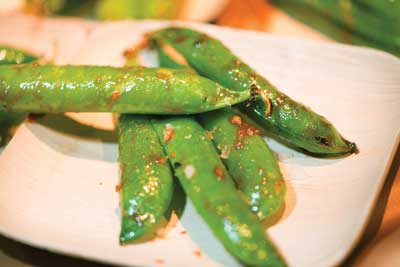 In addition to exhibiting at the IFT15 expo, the company also had a presence at the Culinary Institute of America’s 2015 Worlds of Flavor Conference on Asia and the Theater of World Menus: Flavor Discovery, Culture, Innovation, and Style conference. There, Paul Qui, chef/owner of qui in Austin, Texas, developed a number of food samples made with various Kikkoman ingredients. Drawing on his training in classic Japanese and French cuisines, Qui, who was born in the Philippines, chose ingredients that blended East and West in Spicy English Peas, Grilled Turnips with Uni Powder and Tamari Butter (uni is dried sea urchin), Hamachi Kinilaw (hamachi, or yellowtail, is a firm, mild-flavored fish and kinilaw is a raw seafood dish similar to ceviche that is served in the Philippines), Soy Powder Baked Potatoes, Roasted Sunchokes, and Binchotan Hamachi (binchotan is a type of charcoal made in Japan that burns extremely hot but produces almost no smoke and no flames).
In addition to exhibiting at the IFT15 expo, the company also had a presence at the Culinary Institute of America’s 2015 Worlds of Flavor Conference on Asia and the Theater of World Menus: Flavor Discovery, Culture, Innovation, and Style conference. There, Paul Qui, chef/owner of qui in Austin, Texas, developed a number of food samples made with various Kikkoman ingredients. Drawing on his training in classic Japanese and French cuisines, Qui, who was born in the Philippines, chose ingredients that blended East and West in Spicy English Peas, Grilled Turnips with Uni Powder and Tamari Butter (uni is dried sea urchin), Hamachi Kinilaw (hamachi, or yellowtail, is a firm, mild-flavored fish and kinilaw is a raw seafood dish similar to ceviche that is served in the Philippines), Soy Powder Baked Potatoes, Roasted Sunchokes, and Binchotan Hamachi (binchotan is a type of charcoal made in Japan that burns extremely hot but produces almost no smoke and no flames).
Sensient Adds to Chili Pepper Line
Indian cuisine is about as diverse as they come, with each region having its own distinctive ingredients and dishes. Recognizing the growing popularity of Indian cuisine among American consumers, Sensient Technologies, Milwaukee (sensient.com), recently debuted several ingredients for product developers to use in such products like sauces and spice blends. One of its divisions, Sensient Natural Ingredients, Turlock, Calif. (sensientnaturalingredients.com), added three Indian chili pepper varietals to its chili pepper collection.
Indian farmers and agricultural experts have developed chili pepper hybrids with specific heat levels and flavors to add distinction to many dishes across the subcontinent. Each of the three chili peppers in Sensient Natural Ingredients’ collection hails from specific regions in India. This plays into something that market researchers have noted for some time now—that consumers are moving beyond a generalization of a cuisine and are actually interested in regional cuisines and ingredients that are part of the larger cuisine. Taking this one step further is consumers’ desire for more authentic ingredients, says Roger Lane, marketing manager of savory flavors North America at Sensient Flavors, Hoffman Estates, Ill. (sensientflavors.com). With the new chili pepper varietal ingredients, product developers will be able to give their consumers the heat level and flavor of the authentic chili pepper from a specific region.
Grown in southeast India, the devanur chili has a medium heat level and earthy and nutty flavors. This red-brown chili pepper powder is traditionally used in many Indian dishes. The byadgi chili comes from Karnataka in southwest India and gives a pungent-sweet flavor and mild heat to foods. Rounding out the collection is the teja chili, a very hot chili pepper grown in Andhra Pradesh in southeast India. This chili pepper is not just about heat; it has smoky-sweet flavor undertones. The teja chili powder was featured in a Butter Chicken product concept developed for the IFT15 expo. These chili pepper powders join some other Asian cuisine-inspired ingredients released last year. Red Sriracha, Indian Curry, and Thai Arbol Chili are part of the Chili Blends collection made from chili peppers, onion, garlic, and other ingredients.
--- PAGE BREAK ---
 In addition to releasing these Indian chili pepper varietals this summer, Sensient Flavors highlighted mirch, which in Hindi refers to dried and powdered red chili peppers used to add spiciness to curries. The company did so in an interesting way—by creating Maple Mirch Flavor that combines the sweetness of maple with earthy and spicy notes of chili peppers. The food scientists who developed the flavoring actually went a step further and also included notes of general Indian spice that garam masala imparts, explains Jean Shieh, marketing manager at Sensient Natural Ingredients. The goal in developing this flavor was to have a balanced blend of the familiar flavor of maple with the warmth of Indian spice, she adds. The Maple Mirch Flavor is not just for use in products like Indian sauces or snack foods; it can be used in beverages and bakery, too. The company served Maple Mirch Iced Coffee and Maple Mirch Mini Corn Muffins, both formulated with the flavoring at its booth during the IFT15 expo. The flavoring was also featured in Butter Chicken along with Garam Masala Flavor and Teja Chili Powder. For more Indian cuisine flavors, Sensient Flavors also offers Coriander Chutney Type, Green Coconut Type, and Tamarind WONF.
In addition to releasing these Indian chili pepper varietals this summer, Sensient Flavors highlighted mirch, which in Hindi refers to dried and powdered red chili peppers used to add spiciness to curries. The company did so in an interesting way—by creating Maple Mirch Flavor that combines the sweetness of maple with earthy and spicy notes of chili peppers. The food scientists who developed the flavoring actually went a step further and also included notes of general Indian spice that garam masala imparts, explains Jean Shieh, marketing manager at Sensient Natural Ingredients. The goal in developing this flavor was to have a balanced blend of the familiar flavor of maple with the warmth of Indian spice, she adds. The Maple Mirch Flavor is not just for use in products like Indian sauces or snack foods; it can be used in beverages and bakery, too. The company served Maple Mirch Iced Coffee and Maple Mirch Mini Corn Muffins, both formulated with the flavoring at its booth during the IFT15 expo. The flavoring was also featured in Butter Chicken along with Garam Masala Flavor and Teja Chili Powder. For more Indian cuisine flavors, Sensient Flavors also offers Coriander Chutney Type, Green Coconut Type, and Tamarind WONF.
Yeast Ingredients Enhance Umami, Savory Flavors
Product developers can capture the salty, rich umami, and brothy flavors characteristic of many Asian foods by using such ingredients as flavorings and yeast extracts in their food formulas. Savoury Systems International, Branchburg, N.J. (savourysystems.com), demonstrated some of these ingredients in Asian-inspired product concepts available for sampling at the IFT15 expo.
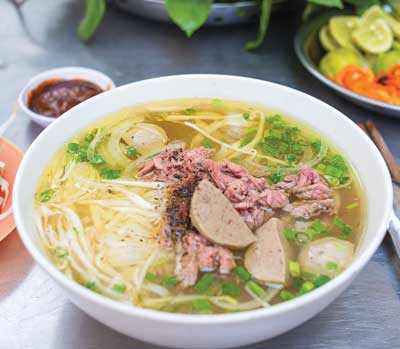 Broth is the base for several dishes like pho. The company featured its yeast-based Chicken Type Flavor, Beef Type Flavor, and Mirepoix Type Flavor in Instant Broth product concepts designed to be used in single-serve coffee makers like the Keurig. Taking broth to the next level, Jovany Chanying, who works on product development and culinary applications for the company, created Vietnamese Pho. Pho is a time-intensive dish to make, involving the cooking of bones, meat, and fat along with aromatics to produce a rich broth. For consumers looking for convenience, there are packaged pho products such as Pacific Foods Chicken Pho Soup Base and Star Anise Foods Happy Pho Vietnamese Brown Rice Pho Noodle Soup made with ingredients that produce the meaty flavors of traditionally prepared pho. For Savoury Systems’ version, Chanying used Flavormax yeast extract to give the pho product concept a rich mouthfeel and umami taste that would normally be achieved from long cook times.
Broth is the base for several dishes like pho. The company featured its yeast-based Chicken Type Flavor, Beef Type Flavor, and Mirepoix Type Flavor in Instant Broth product concepts designed to be used in single-serve coffee makers like the Keurig. Taking broth to the next level, Jovany Chanying, who works on product development and culinary applications for the company, created Vietnamese Pho. Pho is a time-intensive dish to make, involving the cooking of bones, meat, and fat along with aromatics to produce a rich broth. For consumers looking for convenience, there are packaged pho products such as Pacific Foods Chicken Pho Soup Base and Star Anise Foods Happy Pho Vietnamese Brown Rice Pho Noodle Soup made with ingredients that produce the meaty flavors of traditionally prepared pho. For Savoury Systems’ version, Chanying used Flavormax yeast extract to give the pho product concept a rich mouthfeel and umami taste that would normally be achieved from long cook times.
Kokumi is a taste concept described as “mouthfulness” or heartiness that is perceived by calcium channels on the tongue. To provide a kokumi sensation to foods, Savoury Systems developed Kokumi Type Flavor, which it showcased in beef prepared in the style of Korean BBQ. Chanying marinated beef in a blend of applesauce, molasses, sugar, garlic, ginger, and the Kokumi Type Flavor, which enhances the natural meatiness in the beef and brings out a luscious taste, he explains. The Kokumi Type Flavor is not just for meat applications; it also enhanced the flavors of pickled carrot served alongside the Korean BBQ beef.
Umami is a taste often described as savory, and when you think of savory foods, you probably do not think of sweet confections. But Chanying surprised expo attendees by developing Black Pepper Umami Caramels. The sweet-salty combination of caramels topped with sea salt is quite popular. Chanying took caramels to the next flavor level by formulating Umami Type Flavor into them. Here, the ingredient gave the caramels a rich savory note while cutting down a bit of the sweetness. The product concept also demonstrated how the Umami Type Flavor holds up in applications that are cooked at a high temperature, as caramel is.
Creative Concepts With an Asian Theme
Ingredient suppliers are always pushing the envelope when it comes to formulating new product concepts in which to showcase their ingredients. Given the popularity of Asian cuisine, it’s quite common to see plenty of Asian-inspired concepts at food industry events.
At the IFT15 expo, the U.S. Dairy Export Council took an American breakfast favorite—the pancake—and gave it a Korean twist with spicy kimchi. The Savory Kimchee-se Pancake paired the fermented flavor of kimchi with creamy Monterey Jack pepper cheese. It featured milk protein concentrate 70 for added protein and enhanced texture and whey permeate for salty enhancement. Also at the event, Ardent Mills, Denver, Colo. (ardentmills.com), showed how its Ultragrain flour can up the nutritional content of baked goods used in Korean BBQ Pork Tacos (Ultragrain Plus Protein Flour) and Korean BBQ Steamed Buns (Ultragrain Hard Flour). Diana Naturals, Valley Cottage, N.Y. (diana-naturals.com), used its pumpkin juice concentrate, Thai chili flakes, lime juice powder, and onion juice concentrate in a Bangkok Pumpkin Curry Sauce served as an accompaniment to chicken satay. The company also served Korean beef bulgogi with a sesame-ginger sauce.
--- PAGE BREAK ---
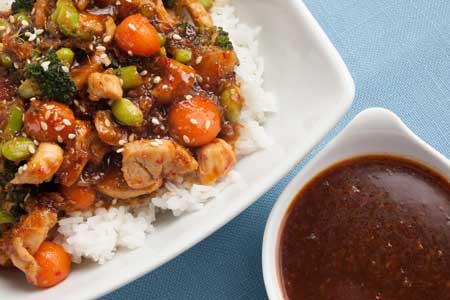 David Michael & Co., Philadelphia (dmflavors.com), developed kimchi slaw flavored with Natural Flavor for Kimchi Dressing Powder and Natural Apple Cider Vinegar Toner to top chicken bratwurst. Another Korean-inspired product concept, Korean Gochujang BBQ Stir Fry Sauce from Ingredion, Westchester, Ill. (ingredion.us), had improved viscosity with PENPURE 37 waxy rice starch.
David Michael & Co., Philadelphia (dmflavors.com), developed kimchi slaw flavored with Natural Flavor for Kimchi Dressing Powder and Natural Apple Cider Vinegar Toner to top chicken bratwurst. Another Korean-inspired product concept, Korean Gochujang BBQ Stir Fry Sauce from Ingredion, Westchester, Ill. (ingredion.us), had improved viscosity with PENPURE 37 waxy rice starch.
To demonstrate its capabilities in developing on-trend flavors and seasoning blends, Wixon, St. Francis, Wis. (wixon.com), often presents globally inspired product concepts at trade shows and events. Asian-specific concepts featured at the CIA’s Worlds of Flavor conference included lumpia and two banh mi sandwiches. Lumpia is a Filipino version of an egg roll made from a thin wrapper filled with vegetables, meat (usually pork), and/or seafood and then deep fried. Wixon’s Pork Lumpia with Green Papaya Salad and Peanuts was filled with pork seasoned with Lumpia Seasoning, a blend of black pepper, brown sugar, soy sauce, ground ginger, and onion, and cabbage, carrots, green onions, and broccoli rabe. The banh mi sandwich can trace its beginnings to French colonial Vietnam, where the French introduced the baguette to the Vietnamese. (The Vietnamese started referring to the bread as banh mi, which means bread made from wheat.) A typical banh mi sandwich has ingredients like cilantro, pickled daikon, jalapeno peppers, and liver pate, but many variations exist made with mushrooms, different vegetables, proteins like tofu, chicken, seafood, beef, and pork, and a variety of herbs and spices. Wixon’s chefs and food technologists seasoned sausage with Thai Sausage Blend and pickled daikon and carrot with Pickling Seasoning for the Thai Sausage Banh Mi. Sambal kaffir mayonnaise spread on the baguette gave it additional flavor. The other banh mi sandwich, Char Siu Pork Banh Mi, was layered with flavor, starting with pork tenderloin marinated in Wixon’s Char Sui Marinade, a blend of hoisin seasoning, Chinese five spice powder, and brown sugar, and then grilled. Pickled fennel lent a sour tang while sprouted vegetables gave a fresh flavor and a bit of a crunch to the sandwich. Fermented black bean aioli made with the company’s Asian Aioli Seasoning was the finishing touch.
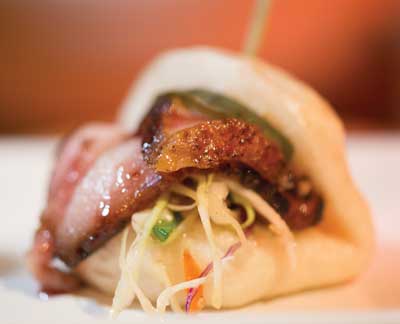 Also at the Worlds of Flavor conference was Frank Dominguez, corporate chef at Smithfield Foods, Smithfield, Va. (smithfieldfoods.com), who featured the company’s key ingredient—pork—in Korean Pork Belly Burnt End Slider on Steamed Bun and Vietnamese Pork Cheek Taco. He says that pork, which is a primary protein used in many Asian cuisines, accepts flavor very well. To make pork belly slider, he rubbed the pork with a spicy dry rub seasoning and smoked it with cherry wood. Pieces were stacked on a steamed bun and topped with raspberry wasabi mustard and pickled cucumbers.
Also at the Worlds of Flavor conference was Frank Dominguez, corporate chef at Smithfield Foods, Smithfield, Va. (smithfieldfoods.com), who featured the company’s key ingredient—pork—in Korean Pork Belly Burnt End Slider on Steamed Bun and Vietnamese Pork Cheek Taco. He says that pork, which is a primary protein used in many Asian cuisines, accepts flavor very well. To make pork belly slider, he rubbed the pork with a spicy dry rub seasoning and smoked it with cherry wood. Pieces were stacked on a steamed bun and topped with raspberry wasabi mustard and pickled cucumbers.
SupHerb Farms, Turlock, Calif. (supherbfarms.com), had its executive chef, Scott Adair, on hand at the conference to share samples of three product concepts with attendees. Each featured ingredients from the company’s line of herbs, vegetables, pastes, and purees like the Sweet and Crispy Pork Belly with Thai Red Curry Coconut Sauce made with Thai Red Curry Paste. The company’s Ginger Cilantro Sesame Paste gave a nutty, herby bite to Salt Encrusted King Salmon with Ginger Cilantro Sesame Soy Honey Glaze. The third concept was Seared Scallops Glazed with Sweet & Spicy Indonesian Glaze and Goat Cheese and Gochujang Polenta. This one included Indonesian Style Chili Paste (Sriracha). Thanks to innovative product developers and creative chefs, consumers now have a wide variety of global foods and ingredients at their disposal. While you may not be able to experience another food and culture in the country, says Adair, you can still taste the flavors of far-off exotic places close to home.
Next month’s Ingredients section will discuss some of the ingredients that add sweetness to or enhance the sweetness of foods and beverages.
Asian Sauces Bring Variety to Foods
The use of sauces and other liquid condiments in Asian cuisines is one way to add distinctive flavors, whether it’s a slight sweetness from mirin, umami from fish sauce, or savory and salty from soy sauce. Mizkan Americas, Mount Prospect, Ill. (mizkan.com), manufactures four such ingredients derived from rice that is milled at the company’s facility in California. “Being a Japanese company, we produce ingredients that are original and authentic,” says Dave Sackett, executive director of sales and marketing, food ingredients, at Mizkan Americas.
Mirin is a sweet cooking wine with mild acidity. Mizkan produces its version, Mirin Cooking Wine M-3, by blending a naturally fermented rice extract with corn syrup, water, and salt. Honteri Sweet Seasoning is a mirin-style liquid ingredient for use in teriyaki sauces, marinades, and sukiyaki. Corn syrup is added after fermenting the rice for sweetness. Sake Cooking Wine has salt added to it after fermentation, while Shao Xing Rice Cooking Wine contains salt, natural flavor, and caramel coloring.
Another supplier of Asian sauces—Lee Kum Kee—features many gluten-free or non-genetically modified versions. The company, which is located in City of Industry, Calif. (lkk.com), produces oyster-flavored sauces with a mellow oyster flavor and plenty of umami compounds and soy sauces, including a mushroom-flavored dark soy sauce that combines the rich, salty flavor of soy sauce with the earthy notes of mushrooms. Lee Kum Kee also provides chili sauces in chili garlic, sriracha, and sweet chili versions; black bean garlic sauce made from fermented black beans and garlic; hoisin sauce that combine soybeans, spices, and sugar; and plum sauce made form salted plums, chili peppers, and ginger.
--- PAGE BREAK ---
Beyond Asian Cuisine
Asian ingredients and cuisines are all the rage, but many different foods from other cuisines are equally as engaging. Not only will you find bao and Korean BBQ product concepts, but also ones that draw inspiration from the cuisines of the Mediterranean, Europe, Mexico, and more. Here are some of those to inspire your product development efforts.
Scott Adair, executive chef at SupHerb Farms, Turlock, Calif. (supherbfarms.com), has grown fond of harissa, a sauce traditionally made from either red or green chili peppers, garlic, cumin, and other spices used to accompany some Middle Eastern recipes. While it functions as a stand-alone ingredient, harissa can be blended with other ingredients to make different sauces, where it lends a smoky heat. Adair recently developed a brown butter red harissa sauce and green harissa and yogurt dip for roasted Cornish game hens and fingerling potatoes. Jars of harissa are found in many grocery stores to let consumers experiment with this flavorful sauce. It is usually eaten with couscous, but product developers can use it to formulate dip, spread, and glaze products or use it to flavor meat in frozen entrees.
At the IFT15 expo, the classic Polish dumpling—pierogi—received a gluten-free makeover with whole grain corn flour, corn bran, and pregelatinized corn flour courtesy of Didion Milling, Johnson Creek, Wis. (didionmilling.com). Dip applications offer product developers a great opportunity to get creative with flavors and ingredients representative of various global cuisines. Ingredion has developed a Muhammara Roasted Red Pepper Walnut and Red Lentil Dip product concept. This Middle Eastern-inspired dip featured HOMECRAFT Pulse 5135 Red Lentil Semolina for protein and gluten replacement.
Innova Flavors, Lombard, Ill. (innovaflavors.com), takes taste buds to North Africa, the Middle East, and south of the border with its product concepts. Lemon Harissa Flavor System Natural added zest to Moroccan Lemon Harissa Potato Chips while Za’atar Flavor System Natural spiced up Middle Eastern Za’atar Pita Chips. Hailing from Mexico, Chamoy is a sauce made from fruit like apricot or mango, chili, and lime juice and is often used as a dip. Innova Flavors captured the flavors of this in its Chamoy Spice Flavor System featured in Mexican Chamoy Tortilla Chips. Pebre is a salsa made from cilantro, garlic, onion, chili pepper, cumin, and olive oil (sometimes tomato is added as well) popular in Chile. Chilean Pebre Corn Chips and Chilean Creamy Pebre were flavored with Natural Flavor Pebre Type.
 Karen Nachay,
Karen Nachay,
Senior Associate Editor
[email protected]
References
CCD. 2015. Culinary Trend Mapping Report: Filipino Fresh. CCD Innovation, Emeryville, Calif. ccdinnovation.com.
NRA. 2015. Global Palates: Ethnic Cuisines and Flavors in America. National Restaurant Association, Washington, D.C. restaurant.org.